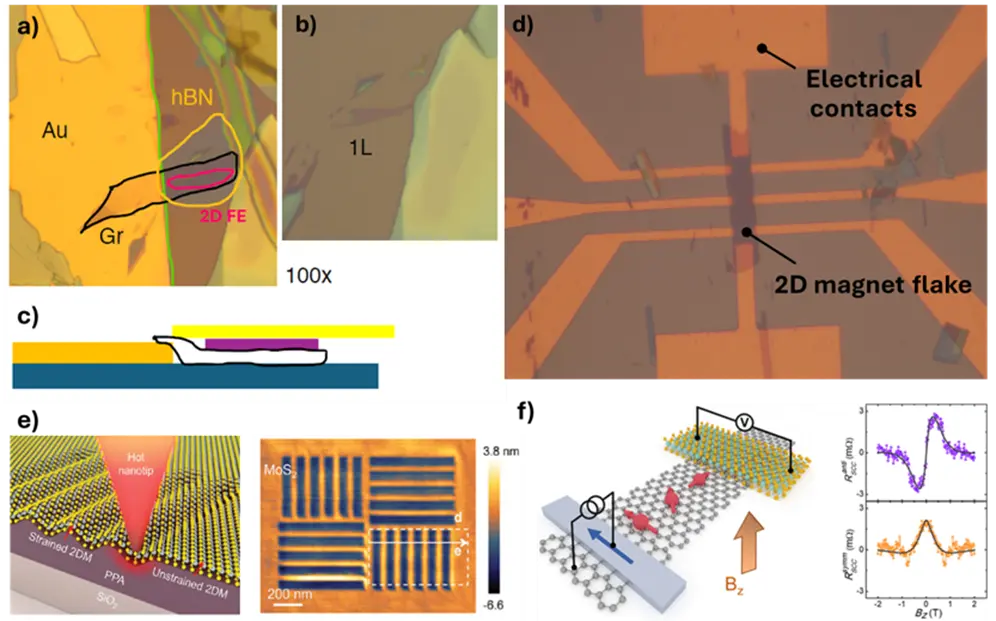Spin-orbit effects in two-dimensional magnets, ferroelectric and multiferroics
Spin-orbit effects in two-dimensional magnets, ferroelectric and multiferroics

Figure 1. (a) A micrometric flake of 2D ferroelectric encapsulated within graphene (Gr) and hexagonal boron-nitride (hBN)-gold to realise a top-to-bottom structure for ferroelectric polarization reversal. (b) A monolayer of 2D ferroelectric. (c) Sketch of the top-bottom geometry used for ferroelectric poling. (d) A flake of exfoliated 2D vdW magnet on top of electrical contacts to realise Hall bars for magneto-transport characterization. (e) Example of thermal manipulation of the local properties of 2D materials using the hot tip of a special atomic force microscope called “nanofrazor”. In this example, heating is used to control the local strain in MoS2 (f) Sketch of the geometry used for spin-to-charge current conversion measurements, and some exemplary results (adapted).
The thesis in a tweet
These thesis works, carried out in collaboration with the Massachusetts Institute of Technology (MIT), will deal with either or both the 2D ferroelectrics and 2D antiferromagnetic materials. The work focuses on the study of their spin-orbit-related properties via transport measurements on micrometric Hall bars.
Abstract
Graphene and two-dimensional materials (2DM) have remained an active field of research in science and engineering for over 15 years after the first reports of 2DM. The vast amount of available data and the high performance of device demonstrators leave little doubt about the potential of 2D materials for applications in electronics, photonics and sensing. Two interconnected topics are available for thesis works.
2D van der Waals ferroelectrics
There exists bidimensional van der Walls (vdW) material that supports ferroelectricity down to the atomic thickness limit. Often, the topological nature of these van der Walls can also allow for efficient spin transport and spin-charge current interconversion mechanisms. The possibility to control the spin transport by acting on the ferroelectric state is a crucial ingredient for spintronic devices beyond CMOS and a demonstration in 2D ferroelectric is still missing. In this context, the thesis will investigate:
- the stabilization of ferroelectricity by laser/heat patterning (Fig. 1a-c);
- the ferroelectric control of spin transport (Fig. 1e-f).
2D van der Waals antiferromagnets and ferromagnets
Other van der Waals materials are well-known for their magnetic properties. The strength of 2D magnetic materials is the extreme tunability of the magnetic properties through electrical gating. The thesis will deal with interfacing 2D vdW magnets (Fig. 1d) with 2D vdW ferroelectrics to demonstrate the non-volatile electric control of the magnetic properties in artificial layered vdW multiferroics.
Both topics will provide the student with key competencies in 2D materials, transport measurements and fabrication techniques carried out in a cleanroom environment.
Where
- The Nanomagnetism Laboratory – Department of Physics, Politecnico di Milano
- Polifab (http://www.polifab.polimi.it), the micro and nanotechnology centre of PoliMI @ Campus Leonardo
Indicative timeline
- Duration: usually from 6 to 9 months, full time
- 4 weeks: cleanroom equipment training; training on electric/ferroelectric/ferromagnetic characterisation of micro and nanostructures.
- The rest of the time: magnetic and ferroelectric characterisation of films in deposited heterostructures; design of devices; realisation of those geometries by lithography; electrical characterisation; physical interpretation of the results. The measurement setups are already at your disposal but may benefit from refinements and extensions, in case this matches the candidate’s skills.
Skills
Prerequisites:
- knowledge of material science / solid-state physics;
Useful competencies (these can anyway be achieved along the way):
- data analysis and programming with Matlab;
- basics of magnetism in matter.
- basics on ferroelectrics (here is my course on the topic);
- basics on micro and nanofabrication.
Expertise acquired during the work:
- micro and nanofabrication techniques
- advanced programming and data analysis with Matlab (or equivalently, Python, etc.);
- magnetic and ferroelectric characterisation of 2D materials;
- advanced electrical characterisation of devices using dc and ac techniques;
- effective scientific communication, data presentation and reporting;
- team work.
Supervisor
Supervisor: Prof. Christian Rinaldi
Co-supervisor: Dott. Federico Fagiani
For further information, do not hesitate to contact Prof. Rinaldi at christian.rinaldi@polimi.it
Additional information
Additional information on my research activity is available at